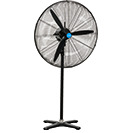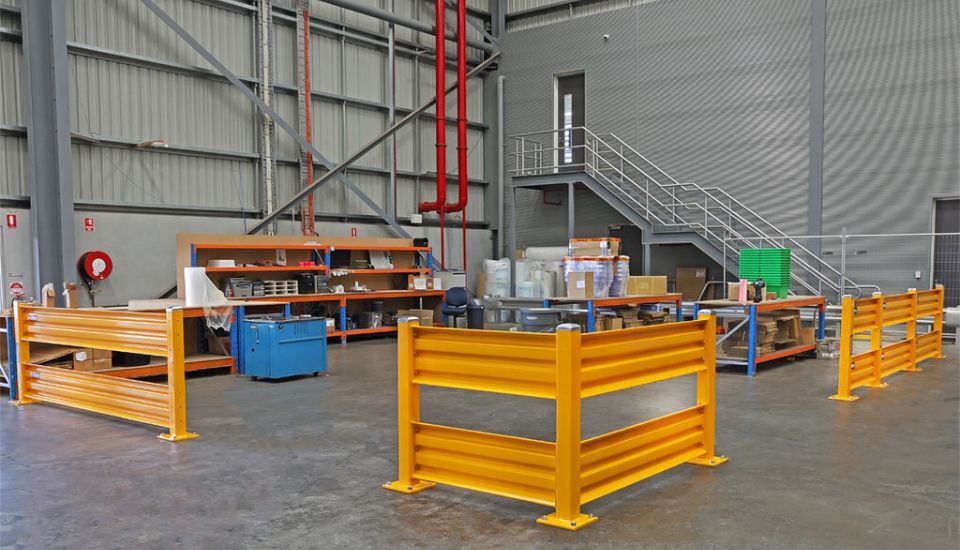5 Key Safety Barrier Tips for Smarter Warehouse Layouts
Date Posted:16 September 2025
Build a safer, more efficient warehouse. These 5 safety barrier considerations will help reduce accidents, protect assets, and support compliance.
Verdex Insights: At a Glance
-
The Challenge: Warehouses must manage constant movement from forklifts, vehicles, and staff while maintaining compliance with safety regulations. Selecting the wrong type of barrier or layout design can lead to collisions, injuries, and operational inefficiency.
-
The Insight: The right safety barriers depend on traffic flow, risk level, and environment. Choosing barriers that are durable, visible, and compliant helps create safer zones, prevent accidents, and improve overall warehouse productivity.
-
The Verdex Solution: Verdex provides WHS-compliant safety barriers, bollards, guard rails, and protective systems for warehousing, logistics, and manufacturing. Our tailored solutions help businesses design safe, efficient layouts that protect people, assets, and operations.
How to Choose the Right Safety Barriers for Your Warehouse Layout
Ensuring the safety of workers, equipment, and inventory in a warehouse is paramount. A well-designed safety barrier system can help mitigate risks, reduce accidents, and protect valuable assets. However, with the vast array of safety barriers available, choosing the right one for your specific warehouse layout can be a challenge.
In this blog, we will guide you through the key considerations for selecting the most appropriate safety barriers for your warehouse.
Why Are Safety Barriers Important in a Warehouse?
Warehouses are often bustling with activity, including the movement of forklifts, automated systems, and foot traffic. With the high volume of operations and machinery, the potential for accidents, damage to infrastructure, and personal injury is always present. Safety barriers play a crucial role in preventing collisions, demarcating safe zones, and ensuring the smooth flow of traffic.
Some of the key benefits of safety barriers include:
-
Preventing damage to racking systems, equipment, and inventory.
-
Protecting pedestrians from being injured by forklifts or machinery.
-
Directing traffic flow and separating different operational zones.
-
Ensuring compliance with safety regulations and industry standards.
Choosing the right barriers for your warehouse layout ensures that these benefits are maximised, creating a safer, more efficient work environment. At Verdex, we specialise in providing material handling equipment and warehouse safety solutions designed to protect both staff and assets.
1. Assess Your Warehouse’s Traffic Flow
Before selecting any safety barriers, it’s essential to understand the specific layout of your warehouse and the types of traffic it accommodates. Different areas of the warehouse will require different barrier systems based on their traffic flow and the level of risk involved.
Types of Traffic to Consider:
-
Forklifts and Vehicles: Forklifts and other vehicles pose a significant risk in high-traffic areas. If your warehouse involves heavy vehicle movement, you’ll need barriers that can absorb impacts and protect both workers and infrastructure.
-
Pedestrian Traffic: Areas where employees walk, such as picking zones or offices, should have barriers designed to protect them from moving vehicles.
-
Storage Areas: For high-traffic racking systems or shelves with valuable inventory, barriers should prevent accidents that could lead to damage to stock or equipment.
-
Loading Docks: High-traffic loading docks can benefit from barriers that control vehicle access and prevent accidental collisions with loading equipment.
By understanding the different types of traffic in your warehouse, you can better assess which barriers will be most effective in each zone. Bollards and safety barriers are a reliable way to create physical boundaries and reduce collision risks.
2. Determine the Type of Safety Barrier Required
Once you have a clear understanding of your traffic flow, the next step is to select the type of barrier that best suits each area of your warehouse. There are several different types of safety barriers, each designed for a specific purpose.
Common Types of Safety Barriers:
-
Guard Rails: Guard rails are commonly used to protect racking systems, shelving units, and other infrastructure from being damaged by forklifts. These barriers are durable and provide a clear physical boundary for vehicles, reducing the risk of collisions.
-
Pedestrian Barriers: Pedestrian barriers are designed to protect employees from moving vehicles. They are typically installed in walkways or areas where foot traffic is frequent, ensuring pedestrians remain safe from forklifts and other heavy equipment.
-
Forklift Barriers: Specially designed forklift barriers are essential in areas where forklift traffic is high. These barriers are built to withstand the impact of forklifts and can prevent accidents that might otherwise cause significant damage to equipment and inventory.
-
Bollards: Bollards are another essential component of warehouse safety. These small, upright posts are perfect for protecting loading docks, entrances, and other vulnerable areas. Bollards absorb impact and are especially effective in high-risk zones where forklift traffic is prevalent.
-
Machine Guarding Barriers: If your warehouse involves automated machinery, machine guarding barriers are crucial. These barriers prevent workers from entering dangerous zones near automated systems, protecting both employees and machinery.
Choosing the right type of safety barrier depends on the specific risks associated with each zone in your warehouse. High-traffic zones and areas with machinery will require more robust solutions, such as heavy-duty guard rails or forklift barriers. In contrast, areas designated for pedestrian traffic will benefit from lightweight, yet effective, pedestrian barriers.
Alongside barriers, investing in a full range of workplace safety equipment and supplies ensures warehouses are prepared to handle risks from every angle.
3. Consider Durability and Impact Resistance
The durability of the safety barriers you choose is critical in ensuring long-term effectiveness. Warehouse environments are often subject to harsh conditions, including heavy vehicle traffic, frequent impacts, and changes in temperature. Therefore, it’s essential to select barriers that are designed to withstand these conditions and offer consistent protection over time.
Factors to Consider:
-
Material: Safety barriers are typically made from materials such as steel, rubber, or plastic. Steel barriers are particularly durable and ideal for high-impact areas where they will regularly face vehicle collisions. Rubber barriers are more flexible and can absorb impacts without damaging the surrounding infrastructure. Plastic barriers are often used in pedestrian zones, offering visibility and moderate protection.
-
Corrosion Resistance: Depending on your warehouse’s location (especially if exposed to humidity or chemicals), corrosion-resistant barriers might be necessary. Galvanised steel or powder-coated finishes can help ensure the longevity of barriers, even in challenging environments.
-
Impact Absorption: In high-traffic areas where collisions are likely, barriers that can absorb and distribute impact energy are essential. Rubber or foam-filled barriers are often used in these areas due to their ability to cushion impacts and protect both the warehouse infrastructure and the vehicle involved in the collision.
Choosing barriers that are both durable and impact-resistant will help reduce the need for frequent repairs and replacements, saving you money in the long run. Even with clear boundaries in place, it’s vital that warehouses are also equipped with accessible workplace first aid kits to respond quickly if an incident does occur.
4. Evaluate Visibility and Aesthetics
Visibility is a crucial factor in warehouse safety. Barriers should be highly visible to both forklift operators and pedestrians, ensuring that everyone is aware of their presence and avoids accidental collisions.
Visibility Features to Consider:
-
Bright Colours: Safety barriers should be painted in bright colours, such as yellow or orange, to increase visibility. High-visibility barriers help workers and vehicle operators see the barriers from a distance, preventing accidents.
-
Reflective Tape or Stripes: Some barriers come with reflective stripes or tape, which are especially useful in low-light conditions or areas with poor visibility. This extra touch can significantly enhance safety during night shifts or in dimly lit warehouse corners.
-
Clear Signage: In addition to visible barriers, signage can be used to further indicate the purpose of the barriers and to enforce safety rules. Simple signs indicating “No Entry” or “Pedestrian Zone” can enhance the safety benefits of physical barriers.
Although visibility is paramount, aesthetics also play a role in maintaining a clean and organised appearance in your warehouse. The safety barriers you choose should fit seamlessly into your warehouse design while providing maximum safety.
To reinforce these boundaries, pairing barriers with workplace safety signage ensures workers are constantly reminded of hazards and safe pathways.
5. Ensure Compliance with Safety Regulations
Warehouse safety is not just about protecting workers and assets; it is also about ensuring compliance with safety regulations. In Australia, businesses must adhere to standards set by WorkSafe Australia and other regulatory bodies. Non-compliance can result in fines, legal issues, and insurance complications.
Key Compliance Considerations:
-
Safety Standards: Ensure the safety barriers you choose meet Australian safety standards, including those related to impact resistance, visibility, and structural integrity.
-
Risk Assessment: A proper risk assessment should be conducted to determine the safety barriers required for each zone. This helps ensure that your warehouse complies with industry regulations while reducing potential liabilities.
Investing in safety barriers that meet or exceed compliance requirements will help protect your business from legal risks and ensure that you maintain a safe working environment for your employees.
Outfitting teams with the right PPE clothing and safety gear is one of the most effective ways to meet this obligation and reduce injuries.
Choose the Right Barriers for Your Warehouse Today
Choosing the right safety barriers for your warehouse is a vital step in creating a safe, efficient, and productive environment. By carefully assessing your traffic flow, selecting the appropriate barrier types, and considering durability, visibility, and compliance, you can ensure that your warehouse is well-protected from accidents, damage, and injuries.
Get in Touch with the Verdex Team
Ready to improve your warehouse safety and efficiency with the right barriers? The team at Verdex is here to help you choose solutions tailored to your layout and operational needs.
-
Email sales@verdex.com.au
-
Or simply fill out our online contact form and we’ll respond promptly
From safety barriers to complete workplace safety equipment and supplies, Verdex can support your business in building a safer, compliant, and more productive warehouse.






















































































 Trolleys & Hand Trucks
Trolleys & Hand Trucks Cage Trolleys
Cage Trolleys Cleaning Carts & Trolleys
Cleaning Carts & Trolleys Construction Trolleys
Construction Trolleys Custom Trolleys
Custom Trolleys Hand Trucks & Dollies
Hand Trucks & Dollies Laundry/Linen Trolleys
Laundry/Linen Trolleys Lifting Trolleys
Lifting Trolleys Order Picking Trolleys
Order Picking Trolleys Panel Cart Trolleys
Panel Cart Trolleys Platform Trolleys
Platform Trolleys Powered Trolleys
Powered Trolleys Shelf & Tiered Trolleys
Shelf & Tiered Trolleys Shopping Trolleys
Shopping Trolleys Stainless Steel Trolleys
Stainless Steel Trolleys Tool Trolleys
Tool Trolleys Utility & Service Carts
Utility & Service Carts Lifting & Handling Equipment
Lifting & Handling Equipment Forklift Attachments
Forklift Attachments Jib Attachments
Jib Attachments Lifting Hoists & Pallet Hooks
Lifting Hoists & Pallet Hooks Load Skates & Tow Tugs
Load Skates & Tow Tugs Manual Stackers & Lifters
Manual Stackers & Lifters Pallet Jacks
Pallet Jacks Pallet Lifters
Pallet Lifters Pallet Rotators & Dispenser
Pallet Rotators & Dispenser Powered Pallet Trucks & Electric Lifters
Powered Pallet Trucks & Electric Lifters Scissor Lift Trolleys and Tables
Scissor Lift Trolleys and Tables Conveyor Equipment
Conveyor Equipment Conveyor Frames & Stands
Conveyor Frames & Stands Roller & Skate Conveyors
Roller & Skate Conveyors Ladders & Access Equipment
Ladders & Access Equipment Container & Yard Ramps
Container & Yard Ramps Ladders & Step Stools
Ladders & Step Stools Work Platforms & Crane Cages
Work Platforms & Crane Cages Drum Handling Equipment
Drum Handling Equipment Drum Storage & Bunding
Drum Storage & Bunding Drum Trolleys & Lifters
Drum Trolleys & Lifters Forklift Drum Handling
Forklift Drum Handling Waste Handling & Bins
Waste Handling & Bins Bin Lifters & Tippers
Bin Lifters & Tippers Plastic Waste & Wheelie Bins
Plastic Waste & Wheelie Bins Steel Waste & Tipping Bins
Steel Waste & Tipping Bins Waste Carts
Waste Carts Dangerous Goods Storage & Spillage
Dangerous Goods Storage & Spillage Aerosol Cans Storage Cages
Aerosol Cans Storage Cages Bunded Pallets & Storage
Bunded Pallets & Storage Corrosive Goods Storage Cabinets
Corrosive Goods Storage Cabinets DG Storage & Trolleys
DG Storage & Trolleys Flammable Liquid Cabinets
Flammable Liquid Cabinets Forklift Gas Storage Cages
Forklift Gas Storage Cages Site Storage
Site Storage Spill Kits
Spill Kits Shelving & Storage Equipment
Shelving & Storage Equipment Stillage & Transport Cages
Stillage & Transport Cages 750 Series Cage Configurations
750 Series Cage Configurations Heavy Duty Cabinets
Heavy Duty Cabinets Heavy Duty Shelving
Heavy Duty Shelving Mega Bins & Pallets
Mega Bins & Pallets Packing & Workbenches
Packing & Workbenches Parts Trays & Stor-Pak Bins
Parts Trays & Stor-Pak Bins Pegboard & Louvre Panels
Pegboard & Louvre Panels Plastic Bins & Crates
Plastic Bins & Crates Plastic Handling Solutions Bins
Plastic Handling Solutions Bins Plastic Pallets
Plastic Pallets Stack & Nest Bins
Stack & Nest Bins Pallet Racking Accessories
Pallet Racking Accessories Workplace Equipment
Workplace Equipment Modular Workbenches
Modular Workbenches Electric Height-Adjustable Workbenches
Electric Height-Adjustable Workbenches Floor Matting
Floor Matting General Workplace Equipment
General Workplace Equipment Industrial Weighing Scales
Industrial Weighing Scales Packaging Machinery
Packaging Machinery Stationery Cupboards
Stationery Cupboards Storage and Stillage Cages
Storage and Stillage Cages Tool Trolleys
Tool Trolleys Tooling Cabinets
Tooling Cabinets Workshop Fans and Coolers
Workshop Fans and Coolers Safety Barriers, PPE & Signage
Safety Barriers, PPE & Signage Barriers & Bollards
Barriers & Bollards First Aid Equipment
First Aid Equipment Gloves, Knives and PPE
Gloves, Knives and PPE Signage
Signage Cleaning & Site Supplies
Cleaning & Site Supplies Cleaning Equipment
Cleaning Equipment Cleaning Trolleys
Cleaning Trolleys Rubbish Bins
Rubbish Bins Signs & Traffic Supplies
Signs & Traffic Supplies Construction Equipment
Construction Equipment Construction Trolleys
Construction Trolleys Waste Handling
Waste Handling General Site Equipment
General Site Equipment Concrete Equipment
Concrete Equipment Site Storage
Site Storage Lifting Equipment
Lifting Equipment











